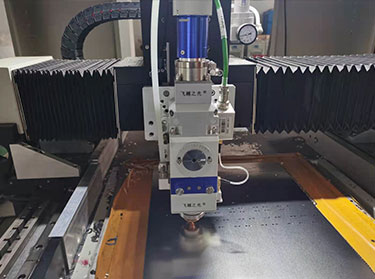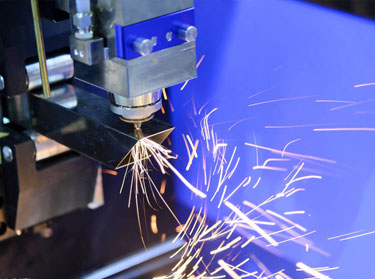The heat input by the light beam (converted by light energy) far exceeds the part reflected, conducted or diffused by the material, and the material is quickly heated to the vaporization temperature and evaporates to form a hole. With the relative linear movement of the beam and the material, the hole continuously forms a slit with a very narrow width (such as about 0.1mm). The thermal effect of trimming is small, and there is basically no deformation of the workpiece. During the cutting process, an auxiliary gas suitable for the material to be cut is added. When cutting steel, oxygen must be used as the auxiliary gas to produce an exothermic chemical reaction with the molten metal to oxidize the material, and at the same time help blow away the slag in the slit. Compressed air is used to cut polypropylene and other plastics, and inert gas is used to cut flammable materials such as cotton and paper. The auxiliary gas entering the nozzle can also cool the focusing lens, preventing smoke and dust from entering the lens holder to contaminate the lens and cause the lens to overheat.
Most organic and inorganic materials can be laser cut. In the metal processing industry, which has a heavy share in industrial manufacturing, many metal materials, regardless of their hardness, can be cut without deformation (the most advanced metal laser cutting machine can cut industrial steel with a thickness close to 20mm). Of course, for high-reflectivity materials, such as gold, silver, copper, and aluminum alloys, they are also good heat transfer conductors, so laser cutting is difficult or even impossible (some difficult-to-cut materials can be cut using pulsed laser beams. Due to the extremely high peak power of the pulse wave, the absorption coefficient of the material to the beam will instantly increase rapidly).

Industry Application:Used in sheet metal, aviation, aerospace, electronics, electrical appliances, subway accessories, automobiles, machinery, precision accessories, ships, metallurgical equipment, elevators, household appliances, craft gifts, tool machining, decoration, advertising, metal external processing, etc. Manufacturing and processing industries.Mainly for cutting carbon steel, silicon steel, stainless steel, aluminum, titanium, galvanized sheet, pickling sheet, galvanized sheet, copper and other metal materials quickly.

Metal laser cutting machine is a laser cutting equipment specially used for cutting and processing metal materials. At present, the mainstream on the market is co2 laser cutting machine, fiber laser cutting machine, and YAG laser cutting machine. It is the mainstream laser cutting equipment in the market. Fiber laser cutting machine is a new technology in recent years, coupled with relatively low technical requirements, metal laser cutting machine equipment is gradually popular.
- High cutting precision and good stability:
- Adopting precision ball screw transmission mechanism, optimizing the control of the numerical control system, can meet the needs of precision parts processing,
- And the dynamic performance is stable, and it can work for a long time.
- Good cutting section quality:
- The mechanical follow-up cutting head system is adopted, the cutting head follows the height of the plate, and the position of the cutting point is always kept unchanged, so that the cutting seam is flat and smooth, and the section does not need post-processing, which is suitable for flat or curved plate cutting.
- The cutting width is large, the material is suitable for cutting, and the application is wide:
- Can cut sheet metal within 2500mm×1250mm;
- Machinable materials are: ordinary carbon steel, stainless steel, alloy steel, aluminum plate, copper plate, titanium plate, etc.
High Cost Performance
For thin plate cutting, it can replace CO2 laser cutting machine, CNC punching machine and shearing machine, etc. The cost of the whole machine is equivalent to 1/4 of CO2 laser cutting machine and 1/2 of CNC punching machine.
Low Cost Of Use
The YAG solid-state laser is used, and the main consumables are electricity, cooling water, auxiliary gas and laser light. The average cost per hour is about 28 yuan.
Core Technologies
- The laser optical system is stable. After thousands of vibration experiments, the laser optical system is stable and unchanging;
- Mechanical follow-up cutting head, pure mechanical transmission, stable anti-interference.
The metal laser cutting machine uses a high-power density laser beam to scan the surface of the material, heat the material to thousands to tens of thousands of degrees Celsius in a very short time, to melt or vaporize the material, and then use high-pressure gas to remove the melted or vaporized material from Blow away in the cutting seam to achieve the purpose of cutting the material. Laser cutting, because the traditional mechanical knife is replaced by an invisible beam, the mechanical part of the laser head has no contact with the work, and will not cause scratches on the work surface during work; laser cutting speed is fast, the cut is smooth and flat, and generally does not need Subsequent processing; small cutting heat-affected zone, small plate deformation, narrow slit (0.1mm~0.3mm); no mechanical stress, no shearing burr; high processing accuracy, good repeatability, and no damage to the surface of the material; CNC programming, Any plan can be processed, and the whole board with a large size can be cut without opening the mold, which is economical and time-saving.
CNC plasma cutting machine is a kind of thermal cutting equipment. Its working principle is to use the heat of high-temperature plasma arc to locally melt the metal at the incision of the workpiece, and use the momentum of the high-speed plasma to remove the molten metal to form an incision. With the development of plasma cutting, the available working gas has a significant impact on the cutting characteristics, cutting quality and speed of the plasma arc. Commonly used plasma arc working gases are argon, hydrogen, nitrogen, oxygen, air, water vapor and some mixed gases. Plasma cutting machines are widely used in automobiles, locomotives, pressure vessels, chemical machinery, nuclear industry, general machinery, engineering machinery, steel structures and other industries.
In terms of cutting accuracy, the plasma is about 1mm, and the laser can reach within 0.2mm; in terms of cutting efficiency, the laser is the superimposition of speed and effect, cutting 1mm boards up to 26 meters per minute. It can be said that plasma is only rough processing, and it is needed later. Grinding for secondary processing is cumbersome, while the laser cutting machine belongs to fine processing and is completed at one time.
Generally speaking, it is recommended to use a CO2 laser cutting machine for cutting carbon steel plates within 20mm, stainless steel plates within 10mm, and non-metallic materials such as acrylic and wood. The laser cutting machine has no cutting force, no deformation in processing: no tool wear, good material adaptability: no matter it is simple or complex parts, it can be cut with precision and rapid prototyping at one time: its slit is narrow, cutting quality is good, and the degree of automation is high. Easy to operate, low labor intensity, no pollution: It can realize automatic cutting and nesting, improve the utilization rate of materials, low production costs, and good economic benefits.
There are many factors to consider when selecting a laser cutting machine. In addition to the maximum size of the workpiece, the material, the maximum thickness that needs to be cut, and the size of the raw material width, more considerations need to be given to the future development direction, such as the product The size of the largest workpiece to be processed after the technical transformation, the breadth of the material provided by the steel market, which is the most economical for its products, and the loading and unloading time.
The laser cutting machine is a technological revolution in sheet metal processing, and it is the “processing center” in sheet metal processing. The laser cutting machine has high flexibility, fast cutting speed, high production efficiency, and short product production cycle. It has won a wide range of customers In the market, this technology has a long effective lifespan. Most foreign plates with a thickness of more than 2 mm use laser cutting machines. Many foreign experts agree that the next 30-40 years will be the golden period for the development of laser processing technology.
Metal laser cutting machine can process materials. Although almost all metal materials have high reflectivity to infrared wave energy at room temperature, CO2 lasers emitting 10.6um beams in the far-infrared band are still successfully used in laser cutting of many metals. practice. Metal’s initial absorption rate of 10.6um laser beam is only 0.5%~10%. However, when a focused laser beam with a power density of more than 106w/cm2 irradiates the metal surface, it can be quickly used in microseconds. The surface began to melt.
The absorption rate of most metals in the molten state rises sharply, generally by 60% to 80%.
Carbon Steel
Modern laser cutting systems can cut carbon steel plates with a maximum thickness of up to 20mm. The cutting seam of carbon steel can be controlled within a satisfactory width by using the oxidation melting cutting mechanism, and the cutting seam for thin plates can be as narrow as about 0.1mm.
Stainless Steel
Laser cutting is an effective processing tool for the manufacturing industry that uses stainless steel sheet as the main component. Under strict control of the heat input in the laser cutting process, the heat-affected zone of the trimming can be restricted from becoming very small, thereby effectively maintaining the good corrosion resistance of this type of material.
Alloy Steel
Most alloy structural steels and alloy tool steels can be used to obtain good trimming quality by laser cutting. Even for some high-strength materials, as long as the process parameters are properly controlled, straight, non-sticky slag cutting edges can be obtained. However, for tungsten-containing high-speed tool steel and hot die steel, there will be erosion and slag sticking during laser cutting.
Aluminum And Alloys
Aluminum cutting is a melting cutting mechanism, and the auxiliary gas used is mainly used to blow away the molten product from the cutting area, and usually a better cut surface quality can be obtained. For some aluminum alloys, attention should be paid to prevent the occurrence of intercrystalline micro-cracks on the surface of the slit.
Copper And Alloys
Pure copper (red copper) basically cannot be cut with CO2 laser beam due to its high reflectivity. Brass (copper alloy) uses a higher laser power, and the auxiliary gas uses air or oxygen, which can cut thinner plates.
Titanium And Alloys
Pure titanium can well couple the heat energy converted by the focused laser beam. When the auxiliary gas is oxygen, the chemical reaction is fierce, and the cutting speed is faster, but it is easy to form an oxide layer on the cutting edge, and it can cause overburn if you are not careful. For the sake of safety, it is better to use air as the auxiliary gas to ensure the cutting quality. The laser cutting quality of titanium alloy commonly used in the aircraft industry is better. Although there will be a little sticky residue at the bottom of the cut seam, it is easy to remove.
Nickel Alloy
Nickel-based alloys are also called super alloys, and there are many varieties. Most of them can be oxidized fusion cutting.
Looking For Powerful Laser Cutting Machine?
Choose Feiyue,Choose Core Advantages
More Than 40 Independent Research Development Patents
